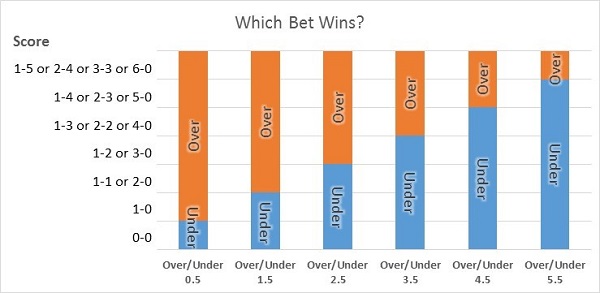
Over/Under is a very popular form of football betting and where a lot of new football punters start. But just because it is simple doesn’t mean that it can’t be a good way to make money.
 Image: Gts (Shutterstock)
Image: Gts (Shutterstock)Over/Under is a great way for people new to betting to get their feet wet…
What Does Over/Under Mean?
With over/under betting, the first thing to understand is that you are betting in relation to the number of goals scored in the game. It doesn’t matter which team scores the goals or even who wins.
You just take the number of goals scored by each of the teams and add them together to get the total goals scored during the game.
The simplicity of this bet is what makes it such a common wager.
When you place an over/under bet, you have to choose two things:
- What “goal line” you want to bet, and
- Whether you bet that the total goals scored in the game will end over or under that goal line.
It doesn’t matter how close the result is to the goal line either, the bet pays the same whether the end result is close to the bet’s goal line or far away.
Why the “Point Five”?
Over/Under bets that end in “.5” have only two outcomes.
You either win the bet and get paid an amount equal to your stake multiplied by the betting odds or you lose the bet and your stake.
Because you can’t score half a goal, every bet is either a win or a loss.
Let’s take the most popular goal line in football: 2.5.
If you think the total goals in the game will be three or more, you would want to bet “Over 2.5”. If you think the total goals in the game will be two or less, you would choose to bet “Under 2.5”.
Over/Under bets without the “.5” or with different fractions (such as 2.25) may return part or all of your stake to you even if you don’t win.
For example, with a Total Goals bet, if you bet “Over 2” and exactly 2 goals are scored, you will not win the wager but you will get your stake refunded.
The graphic below shows which bet (over or under) will win given a certain score in the game for various goal lines.

Attention Please! Some Goals Don’t Count!
When you are betting in football, the only goals that count towards over/under bets are the ones scored during the regulation 90 minutes of each match.
If the game ends tied after 90 minutes any goals scored in extra-time or a penalty shoot-out do not count towards the over/under goals tally.
The result of the match itself does not matter; drawn matches with scorelines like 0-0, 1-1, 2-2, etc., also contribute to over-under bet results.
Over/Under 2.5: The Most Popular Bet in Football
We are using 2.5 as an example here because although there are many possible over/under bets, 2.5 happens to be the most popular goal line for football bets.
It turns out that when you look at a long history of football games, even across different leagues, the average number of total goals scored per game is very close to 2.5.
As a result, you often have a similar number of punters backing each side of the 2.5 goal line where the odds are similar no matter which choice of over or under is made.
Choose Your Bet Using Statistical Information
Bookmakers set the odds of over and under for each available goal line using statistical information on the teams who are playing each other as well as football games in general.
Demand on each side of the bet can change the bookmaker odds and knowing what the statistics say can help you determine whether a particular bet is a good or bad one to take.
The best bet is not always the bet that is closest to the actual score you expect.
In fact, it is often the bets further away from expectations that offer the greatest difference between the betting odds offered in the markets and the true statistical predictions.
Making Money at Over-Under Betting
Some punters are surprised at how important the underlying mathematics are, but long-term success at over/under betting is much more science than art!
Continue to follow our blog to learn more, or check out our book: Fundamentals of Sports Betting.






